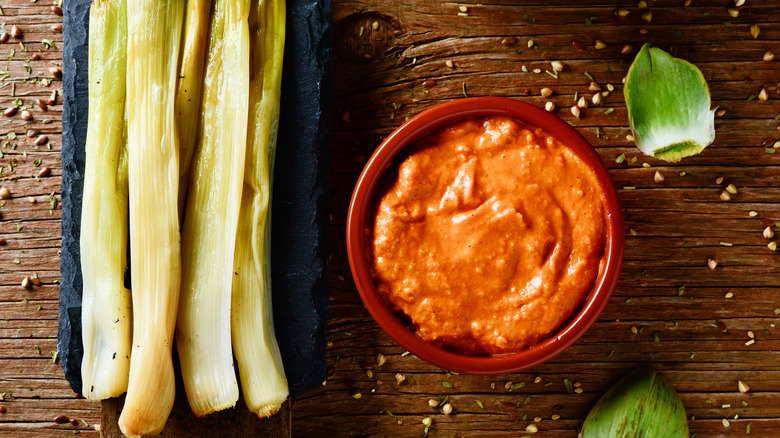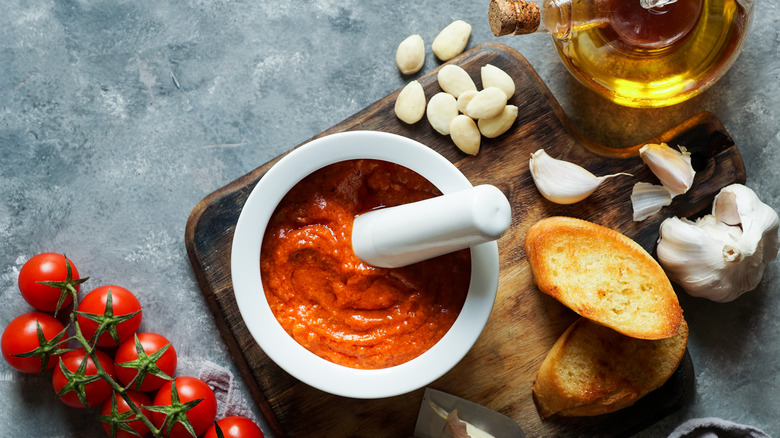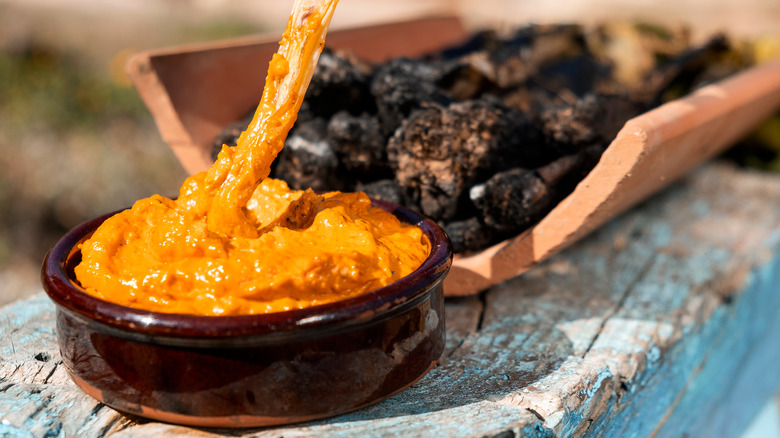What Is Romesco Sauce And What Is It Made Of?
Few sauces have more affinity to Spain than the well-traveled romesco sauce. Originally from Catalonia, the lightly reddish sauce captures the essence of the rustic Mediterranean flavors. Romesco's name comes from the Spanish Muslims of Tarragona, the home to many sauces variations. The term loosely describes the same base used for traditional Catalan seafood stews as in the more familiar cold romesco sauce: no matter the variation, the beautifully ripe tomatoes, garlic, olive oil, and the smokiness of grilled bell peppers are considered a prerequisite for any romesco sauce. Depending on the use, toasted bread and nuts like almonds or hazelnuts are often added to thicken the sauce.
The sauce conquered the hearts of many chefs and home cooks worldwide, with nearly every offering their spin on the recipe — it makes it hard to pick the best one, but this time it isn't our goal. We wanted you to decide what kind of romesco you want on your plate: a chargrilled bitterness of poblano peppers or the deeply intense Spanish paprika. One thing is sure; the grill is where it shines.
The Romesco sauce recipe has few boundaries
Outside of Spain, romesco takes on a completely different shape altogether, becoming a sauce of choice for various foreign dishes: some like mixing it in their noodles or rice, while others prefer to thicken a soup with it. Marc Vidal, executive chef of Boqueriain in New York, loves to dress salads with romesco sauce, particularly the bitter varieties like frisée or escarole.
One common thing unifying all different romesco is that it's always made with precooked ingredients. It gives this sauce its distinctively smokey character and beautifully expressed sweetness. Both tomatoes and peppers are blistered under high heat and then peeled before being crushed into the sauce. Romesco often looks rustic; some chefs even like to use mortar for the job. Having such flexible sauce in the kitchen is terrific, as you can serve romesco hot or cold and still enjoy the same delicious results.
Grilled food is where romesco truly shines
One of the classic seasonal dishes in Catalonia is grilled calçots or spring onions with romesco sauce. The smokey character of romesco is why you often find romesco sauce next to grilled fish, vegetables, or meat. It gives the simple grilled vegetables extra richness, which is particularly great if you want to avoid eating meat or fish. You could try it with plenty more seasonal vegetables from grilled leeks and endive, or for an extra meaty veggie option: a caramelized broccoli with smoky romesco sauce is simply to die for.
Romesco works very well with your grilled burgers, just don't cut corners with the store-bought romesco, as it will never have the depth of freshly grilled peppers or toasted nuts — fresh seasonal produce is what makes romesco the sauce you will be coming back to. And don't be scared to add your touch: a few drops of quality sherry vinegar or a pinch of cayenne pepper will make it even zingier.


